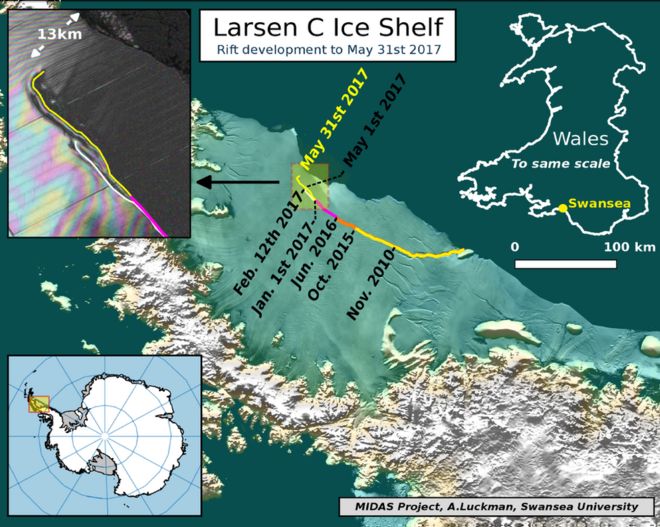Welcome to DU!
The truly grassroots left-of-center political community where regular people, not algorithms, drive the discussions and set the standards.
Join the community:
Create a free account
Support DU (and get rid of ads!):
Become a Star Member
Latest Breaking News
General Discussion
The DU Lounge
All Forums
Issue Forums
Culture Forums
Alliance Forums
Region Forums
Support Forums
Help & Search
Environment & Energy
Related: About this forumAntarctic ice crack takes major turn
"There has been an important development in the big crack cutting across the Larsen C Ice Shelf in Antarctica.
The fissure, which threatens to spawn one of the biggest bergs ever seen, has dramatically changed direction.
"The rift has propagated a further 16km, with a significant apparent right turn towards the end, moving the tip 13km from the ice edge," said Swansea University's Prof Adrian Luckman.
The calving of the berg could now be very close, he told BBC News."
http://www.bbc.co.uk/news/science-environment-40113393

InfoView thread info, including edit history
TrashPut this thread in your Trash Can (My DU » Trash Can)
BookmarkAdd this thread to your Bookmarks (My DU » Bookmarks)
4 replies, 5004 views
ShareGet links to this post and/or share on social media
AlertAlert this post for a rule violation
PowersThere are no powers you can use on this post
EditCannot edit other people's posts
ReplyReply to this post
EditCannot edit other people's posts
Rec (10)
ReplyReply to this post
4 replies
 = new reply since forum marked as read
Highlight:
NoneDon't highlight anything
5 newestHighlight 5 most recent replies
= new reply since forum marked as read
Highlight:
NoneDon't highlight anything
5 newestHighlight 5 most recent replies
Antarctic ice crack takes major turn (Original Post)
muriel_volestrangler
May 2017
OP
lapfog_1
(29,199 posts)1. 1500 sq miles
now that's a big ice cube
Duppers
(28,120 posts)3. Rhode Island sized?
There about.
OKIsItJustMe
(19,938 posts)4. 5,000 sq km is 1,930 sq mi
Rhode Island covers 1,214 square miles (3,144 sq km)
OKIsItJustMe
(19,938 posts)2. Project MIDAS
http://www.projectmidas.org/blog/another-step-closer/
[font face=Serif][center][font size=5]Larsen C takes another step towards calving[/font]
by Adrian Luckman, Martin O'Leary and Project MIDAS[/center]
May 31, 2017
[font size=3]In the largest jump since January, the rift in the Larsen C Ice Shelf has grown an additional 17 km (11 miles) between May 25 and May 31 2017. This has moved the rift tip to within 13 km (8 miles) of breaking all the way through to the ice front, producing one of the largest ever recorded icebergs. The rift tip appears also to have turned significantly towards the ice front, indicating that the time of calving is probably very close.
The rift has now fully breached the zone of soft ‘suture’ ice originating at the Cole Peninsula and there appears to be very little to prevent the iceberg from breaking away completely.
When it calves, the Larsen C Ice Shelf will lose more than 10% of its area to leave the ice front at its most retreated position ever recorded; this event will fundamentally change the landscape of the Antarctic Peninsula. We have previously shown that the new configuration will be less stable than it was prior to the rift, and that Larsen C may eventually follow the example of its neighbour Larsen B, which disintegrated in 2002 following a similar rift-induced calving event.
The MIDAS Project will continue to monitor the development of the rift and assess its ongoing impact on the ice shelf. Further updates will be available on this blog, and on our Twitter feed.[/font][/font]
by Adrian Luckman, Martin O'Leary and Project MIDAS[/center]
May 31, 2017
[font size=3]In the largest jump since January, the rift in the Larsen C Ice Shelf has grown an additional 17 km (11 miles) between May 25 and May 31 2017. This has moved the rift tip to within 13 km (8 miles) of breaking all the way through to the ice front, producing one of the largest ever recorded icebergs. The rift tip appears also to have turned significantly towards the ice front, indicating that the time of calving is probably very close.
The rift has now fully breached the zone of soft ‘suture’ ice originating at the Cole Peninsula and there appears to be very little to prevent the iceberg from breaking away completely.
When it calves, the Larsen C Ice Shelf will lose more than 10% of its area to leave the ice front at its most retreated position ever recorded; this event will fundamentally change the landscape of the Antarctic Peninsula. We have previously shown that the new configuration will be less stable than it was prior to the rift, and that Larsen C may eventually follow the example of its neighbour Larsen B, which disintegrated in 2002 following a similar rift-induced calving event.
The MIDAS Project will continue to monitor the development of the rift and assess its ongoing impact on the ice shelf. Further updates will be available on this blog, and on our Twitter feed.[/font][/font]